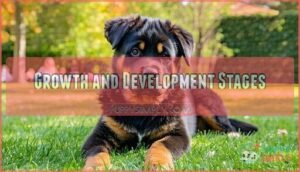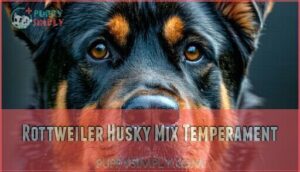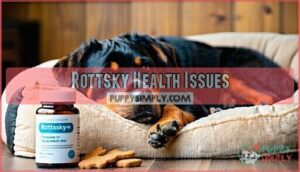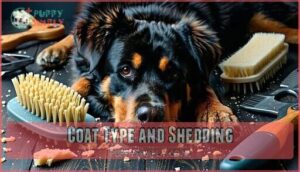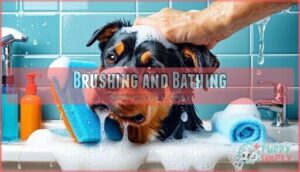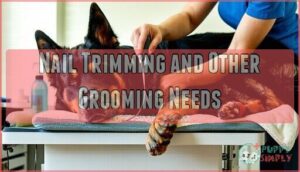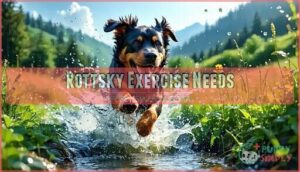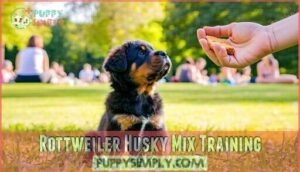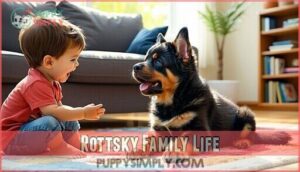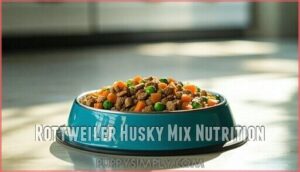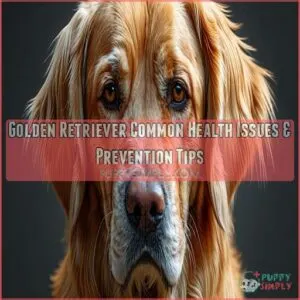This site is supported by our readers. We may earn a commission, at no cost to you, if you purchase through links.
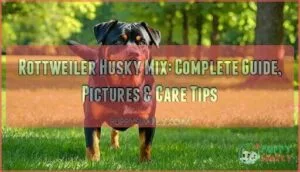
They’re intelligent but need experienced owners who can provide consistent training, daily vigorous exercise, and mental stimulation.
These "Rottskies" typically weigh 50-100 pounds and stand 20-26 inches tall, featuring striking blue or multicolored eyes and double-layered coats in black-tan, brown-white, or solid colors.
While they make devoted family companions and excellent watchdogs, early socialization is vital for proper adjustment around strangers and other pets.
Their moderate to heavy shedding requires regular brushing, and their high energy levels mean they’re not suited for sedentary lifestyles.
The right training approach and exercise routine can release their full potential as remarkable companions.
Table Of Contents
- Key Takeaways
- Rottweiler Husky Mix Overview
- Rottsky Size and Weight
- Rottweiler Husky Mix Temperament
- Rottsky Health Issues
- Rottweiler Husky Mix Grooming
- Rottsky Exercise Needs
- Rottweiler Husky Mix Training
- Rottsky Family Life
- Rottweiler Husky Mix Nutrition
- Rottsky Cost and Care
- Frequently Asked Questions (FAQs)
- Is a Husky Rottweiler mix a good dog?
- How much does Rottsky cost?
- What is a Husky Rottweiler mix called?
- How big can a Rottsky get?
- Are Rottweiler Husky mixes good guard dogs?
- How much do Rottsky puppies typically cost?
- Do Rottskies get along with other dogs?
- Can Rottweiler Husky mixes live in cold climates?
- What age should you start training Rottsky puppies?
- Conclusion
Key Takeaways
- You’ll need significant dog experience – Rottskies combine protective instincts with stubborn independence, requiring consistent training and early socialization that’s too challenging for first-time owners.
- They’re high-energy dogs demanding 60-90 minutes of daily exercise – Without adequate physical activity and mental stimulation, they’ll develop destructive behaviors and become difficult to manage.
- Expect heavy year-round shedding and substantial costs – Their double coats require regular grooming, and you’ll face $600-2,000 upfront plus $900-1,500 annually for food, vet care, and supplies.
- They’re loyal family guardians but need proper socialization – With early training, they become devoted protectors, but their size (55-95 pounds) and guarding instincts require careful management around children and strangers.
Rottweiler Husky Mix Overview
The Rottweiler Husky mix, also called a Rottsky, combines two powerful working breeds into one striking companion.
You’ll get a dog that blends the Rottweiler’s protective nature with the Siberian Husky’s endless energy and stunning eyes.
Origin and History
The Rottweiler Husky mix emerged from the designer dog trend of the past 20-30 years.
Breeders combined the Rottweiler’s protective instincts with the Siberian Husky’s endurance and athleticism. This crossbreed purpose aimed to create a versatile companion suited for active households.
The Rottweiler origins trace to ancient Roman drover dogs, while Husky heritage stems from Alaska’s working sled dogs.
As a mix of popular breeds, the Rottweiler ranked 9th and the Siberian Husky ranked 24th, according to the AKC, making this Rottsky a popular mix.
Physical Characteristics
Your rottweiler husky mix will show a striking blend of both parent breeds.
These dogs typically stand 20-26 inches tall and weigh 55-95 pounds, with a muscular body build that screams power and grace.
Their head shape usually favors the Rottweiler’s stocky structure, while eye color often inherits the Husky’s mesmerizing blues or browns.
Coat texture varies from smooth to rough, with distinctive Rottweiler markings creating a unique appearance that turns heads wherever you go.
Coat Types and Colors
Your Rottsky’s coat texture can range from smooth to rough, inheriting the Husky’s dense double coat or the Rottweiler’s shorter fur.
Common colors include black, brown, gray, red, cream, white, and sable with distinctive markings inheritance from both parents.
Seasonal changes bring heavy shedding periods, requiring increased grooming needs. Color fading may occur with age, affecting the coat’s appearance over time, which can be a significant change.
Rottsky Size and Weight
Understanding your Rottsky’s size helps you prepare for their space and care needs.
These powerful mixed breeds typically range from 20-27 inches tall and weigh between 55-135 pounds when fully grown, which are key factors to consider for their care needs.
Average Height and Weight
When fully grown, your rottweiler husky mix will stand between 22-27 inches tall and weigh 85-135 pounds.
This large breed typically reaches their ideal weight around 18-24 months.
Size inheritance from both parent breeds creates substantial dogs requiring proper weight management throughout their growth timeline.
- Height Range: 22-27 inches at shoulder
- Weight Range: 85-135 pounds when mature
- Growth Period: 18-24 months to reach full size
Factors Affecting Size Variations
Several factors shape your Rottsky’s final size.
Parent genetics play the biggest role – larger parent breeds typically produce bigger puppies.
Nutrition impact during growth affects development, while exercise influence helps build muscle mass.
Environmental factors and gender differences also matter, with males generally reaching greater height and weight than females.
Like their husky parent, this mix needs at least 90 minutes of vigorous activity daily.
| Factor | Impact on Size |
|---|---|
| Parent genetics | Determines baseline height/weight potential |
| Nutrition quality | Affects proper bone and muscle development |
| Exercise levels | Influences muscle mass and overall build |
| Gender differences | Males typically 10-15% larger than females, showing gender size difference |
Growth and Development Stages
Your rottweiler husky mix puppy will reach full size between 18-24 months.
During puppyhood milestones, expect rapid growth spurts and behavioral development. Adolescent changes bring increased energy and testing boundaries.
Adult maturity brings stability in size and temperament.
Senior care begins around 8 years. Proper health monitoring and training throughout each stage guarantees healthy development and good behavior.
Rottweiler Husky Mix Temperament
Understanding your Rottweiler Husky mix’s temperament helps you provide the right training and care for this unique breed.
These dogs combine the Rottweiler’s protective nature with the Husky’s independent spirit, creating a complex personality that requires an experienced owner.
Intelligence and Trainability
Your Rottweiler Husky mix combines sharp intelligence with independent thinking, creating unique Training Challenges.
While these dogs excel at learning, their Stubbornness Factors can test your patience. Mental Stimulation becomes essential for success.
Key training insights for your intelligent companion:
- Consistency beats perfection – Your dog’s Learning Styles require steady, patient guidance
- Mental games prevent boredom – Breed Versatility shines through puzzle-solving activities
- Short sessions work best – Intelligence doesn’t equal endless attention spans
- Positive reinforcement wins – Obedience flows from trust, not dominance
Loyalty and Protective Instincts
Deep within your rottweiler husky mix lies fierce loyalty that transforms them into devoted family guardians.
These dogs form unbreakable family bonds, making them excellent family pets when properly socialized.
Their protective instincts shine through territorial tendencies and natural guarding behaviors inherited from both parent breeds.
However, training impact substantially shapes how these guarding instincts manifest in daily life.
Energy Levels and Exercise Needs
Your Rottsky brings together two powerhouse breeds with serious energy levels that demand respect.
These dogs need 60 to 90 minutes of daily exercise, but it’s not just about quantity—exercise intensity matters tremendously.
Activity variety keeps them engaged, from morning jogs to evening fetch sessions, while weather considerations affect their stamina, and age-related changes and individual differences shape their specific needs for both physical and mental stimulation.
Rottsky Health Issues
While Rottskies are generally healthy dogs, they can inherit health problems from both parent breeds.
You’ll want to watch for common issues like hip dysplasia, eye conditions, and bloat that affect many large dog breeds.
Common Health Problems
Your Rottsky faces several health problems that require your attention.
Joint dysplasia affects hips and elbows, while eye problems include progressive retinal atrophy and cataracts.
Bloat risks increase due to their deep chest, and cancer susceptibility includes osteosarcoma.
Preventative care through regular vet checkups helps catch issues early and maintain your dog’s quality of life.
Large breeds are especially susceptible to gastric dilatation volvulus.
Hip and Elbow Dysplasia
Both hip dysplasia and elbow dysplasia affect your rottweiler husky mix due to genetic predisposition common in large breed dogs.
These joint conditions range from mild to severe based on severity grading systems.
Pain management includes medications and weight control, while surgical options like joint replacement may be necessary for advanced cases.
Preventative measures include proper nutrition and controlled exercise during puppyhood.
Eye Conditions and Bloat
Your Rottsky faces serious eye conditions and bloat risks that need your attention. Progressive retinal atrophy causes gradual blindness, while cataracts cloud vision.
**Watch for eye problems early – your Rottsky’s vision depends on it.
Glaucoma creates painful pressure requiring emergency care. PRA testing helps catch problems early.
Watch for cloudy eyes or discharge. Bloat symptoms include restlessness and swollen abdomen – this demands immediate veterinary intervention to save your dog’s life, due to serious eye conditions and bloat risks that can lead to gradual blindness.
Rottweiler Husky Mix Grooming
Your Rottsky’s double coat requires regular care to manage heavy shedding and keep your dog comfortable.
This grooming routine will help you handle their seasonal coat changes and maintain their health year-round.
Coat Type and Shedding
Your Rottsky’s double coat means you’re dealing with heavy shedders year-round.
These dogs shed constantly, with two major seasonal blowouts that’ll leave fur everywhere.
The medium-length, dense coat isn’t hypoallergenic, so expect daily cleanup, and coat density varies between dogs, but shedding frequency remains high.
You’ll need quality grooming tools to manage this furry situation effectively.
Brushing and Bathing
You’ll want to brush your Rottsky 2-3 times weekly using a slicker brush or undercoat rake to manage their heavy shedding.
During seasonal blowouts, daily brushing becomes necessary. The right slicker brush is essential for effective grooming.
Bath them monthly or when dirty using a gentle dog shampoo designed for double coats. Thorough drying with a blow dryer prevents matting and skin issues, ensuring a healthy and clean Rottsky.
Nail Trimming and Other Grooming Needs
Beyond brushing, your Rottsky needs regular nail trimming every 2-3 weeks to prevent overgrowth and splitting.
Weekly ear cleaning with a gentle solution prevents infections, while daily dental care through brushing or dental chews maintains oral health.
Check paw pads for cuts or debris after outdoor activities.
Overgrown nails can cause joint stress and mobility issues.
These grooming habits complement your coat maintenance routine, keeping your dog comfortable and healthy.
Rottsky Exercise Needs
Your Rottsky needs plenty of exercise to stay happy and healthy. This energetic mix requires 60 to 90 minutes of daily activity to prevent boredom and destructive behavior.
Daily Exercise Requirements
After brushing out that double coat, your buddy’s got energy to burn.
This mix needs about 60 to 90 minutes of vigorous exercise daily—think running, long walks, or a game of fetch.
Watch for breed differences and adjust for weather and age.
Changing up activity variety helps keep the exercise intensity right and their spirits high.
Mental Stimulation and Enrichment
A sharp mind needs constant challenges to stay engaged.
Your Rottsky thrives on puzzle toys and interactive games that make them think.
Try snuffle mats for scent work or agility training to build confidence.
Dog puzzle toys prevent boredom while you’re away.
Canine enrichment activities like hide-and-seek keep their intelligent minds busy and satisfied.
Activities and Games for Rottweiler Husky Mixes
With your Rottsky’s high energy and intelligence, puzzle toys and interactive dog puzzle toys provide mental stimulation while keeping them engaged.
For added enrichment, consider interactive options for dogs.
Try agility training, scent work with a snuffle mat, and fetch games for physical exercise.
Hiking adventures satisfy their endurance needs.
These activities prevent destructive behaviors while strengthening your bond through dog training sessions.
Rottweiler Husky Mix Training
Training your Rottsky requires patience and consistency because these intelligent dogs can be stubborn and independent.
Start socialization early to help them become well-adjusted family companions who can handle new situations with confidence.
Socialization and Obedience
Early Socialization shapes your Rottsky’s future behavior around people and animals.
Start exposing your puppy to different environments, sounds, and experiences during their first 16 weeks. Consistent Training with positive reinforcement builds obedience and manages their strong Guarding Instincts effectively.
Key socialization priorities:
- Puppy classes – Controlled environment for meeting other dogs safely
- Public outings – Grocery stores, parks, and busy streets build confidence
- Household visitors – Regular guests prevent overprotective behavioral issues
Your Rottsky’s intelligence makes dog training rewarding, but their independent streak requires patience. Focus on basic commands like "sit," "stay," and recall training early.
Address any behavioral issues immediately through consistent boundaries and positive reinforcement techniques.
Housebreaking and Leash Training
House training and leash manners form the foundation of your Rottsky’s education.
Start potty training immediately using consistent schedules and positive reinforcement.
Crate training helps establish routines while preventing accidents.
For leash manners, practice in quiet areas before busy streets.
Address marking issues early through redirection and consistent training methods.
Many owners find success with specialized crate products.
| Training Aspect | Timeline | Key Techniques |
|---|---|---|
| Potty Training | 4-6 months | Consistent schedule, praise rewards |
| Crate Training | 2-4 weeks | Gradual time increases, comfort items |
| Leash Manners | 8-12 weeks | Loose leash walking, direction changes |
| Recall Training | 6-8 months | High-value treats, safe environments |
| Marking Issues | Ongoing | Immediate correction, outdoor redirection |
House training and leash manners are crucial for your Rottsky’s development, and consistent training is key.
Positive reinforcement and redirection are effective methods for addressing behavioral issues.
By following these guidelines and using the right tools, you can help your Rottsky become a well-behaved companion.
Addressing Behavioral Issues
Problem behaviors in mixed breeds often stem from boredom and inadequate mental stimulation.
Destructive behavior and excessive barking typically indicate unmet exercise needs, while prey drive requires consistent training and secure fencing.
Separation anxiety responds well to gradual conditioning and interactive toys.
Address aggression issues through early socialization and professional guidance when needed.
Rottsky Family Life
Adding a Rottsky to your family requires careful consideration of your living situation and experience level.
These powerful, intelligent dogs need the right environment and dedicated owners to thrive as loving family companions.
Compatibility With Children
Your Rottsky’s compatibility with kids depends on proper socialization and age considerations.
These family dogs do best with older children who understand safe interactions.
Child supervision is essential during playdate dynamics due to their large size and high energy.
Temperament testing helps predict their sociability with kids.
Supervised interactions teach both your family pet and children appropriate boundaries for successful relationships.
Some breeds, like the loyal Cardigan Welsh Corgi, are known to be great family pets.
Suitability for First-Time Dog Owners
Why would you sign up for such a challenge?
First-time owners face significant hurdles with Rottskies due to training difficulty and breed independence.
Their exercise commitment demands 90+ minutes daily, while guarding tendencies and potential destructiveness emerge without proper guidance.
These behavioral issues require experienced handling. Most experts strongly advise against this mix for beginners seeking their first dog training experience.
Apartment Living and Space Requirements
Rottsky dogs aren’t suited for apartment living due to their large size and high energy levels.
These powerful breeds need space to move and exercise alternatives when fenced-in yards aren’t available.
Consider these apartment suitability factors:
- Size requirements – At 55-95 pounds, they need room to stretch and play indoors
- Exercise alternatives – Daily walks, stair climbing, and indoor games become essential without yards
- Noise levels – Their vocal nature may disturb neighbors and violate breed restrictions
- Energy levels – High-energy dogs require constant mental stimulation in confined spaces
Rottweiler Husky Mix Nutrition
Proper nutrition forms the foundation of your Rottsky’s health and longevity throughout their active life.
Understanding their unique dietary requirements helps you provide the balanced nutrition this energetic mixed breed needs to thrive.
Dietary Needs and Recommendations
Your Rottsky needs high-quality dog food formulated for large, active breeds.
Puppy nutrition differs from senior diets, requiring age-appropriate formulas. Watch for food sensitivities and sensitive stomach issues.
Weight management becomes important as they age. Consider supplement needs based on activity level and health conditions.
Quality diet supports overall longevity and health.
Feeding Schedule and Portion Control
Adult Rottskies need two meals daily to prevent bloat and maintain steady energy.
Puppies require three to four smaller portions until six months old.
Measure portions based on your dog’s weight and activity level – active dogs need more calories than couch potatoes.
Senior dogs often need smaller, more frequent meals for easier digestion and weight management.
Avoiding Common Food Allergies
Food allergies can turn mealtime into a minefield for your Rottsky.
Watch for signs like itchy skin, digestive upset, or ear infections.
Novel proteins and limited ingredient dog food help identify triggers.
Grain-free diets work for some dogs with sensitivities.
Consider allergy testing if problems persist.
Probiotics support gut health and may reduce food sensitivities in dogs with sensitive stomachs.
Rottsky Cost and Care
Owning a Rottsky means planning for both upfront and ongoing costs that can add up quickly.
You’ll need to budget for everything from the initial purchase or adoption fees to regular veterinary care, quality food, and potential emergency medical expenses throughout your dog’s 9-14 year lifespan, considering the ongoing costs.
Purchasing and Adoption Costs
Your initial investment for a rottweiler husky mix puppy ranges from $600 to $2,000, depending on the breeder’s reputation and location.
Dog adoption from rescues costs substantially less but requires patience finding available dogs.
Cost breakdown considerations:
- Breeder vs. Rescue: Reputable breeders charge more but provide health testing and early socialization
- Initial Investment: Include supplies, vaccinations, and spaying/neutering in your budget
- Hidden Fees: Transportation, deposits, and registration papers add to the base price
Financial preparation helps avoid surprises when bringing your new companion home.
Ongoing Care and Maintenance Expenses
Beyond the initial investment, you’ll face ongoing expenses that add up quickly.
Food costs range from $50-80 monthly for quality large-breed diet. Vet expenses average $800-1,200 annually for routine health checkups and vaccinations.
Grooming supplies cost $30-50 monthly, while training fees can reach $500-800 for professional classes. Toy replacement becomes necessary due to their destructive tendencies, adding $20-40 monthly.
These combined costs require careful budgeting for proper veterinary attention and care.
Insurance and Veterinary Care Options
Pet insurance helps protect your wallet from unexpected vet costs, especially for breed-specific ailments like hip dysplasia and eye problems.
Most plans cover hereditary conditions common in Rottskies, reimbursing up to 90% of veterinary attention after deductibles. Rottweilers face cancer risks, making early enrollment beneficial.
Consider these insurance factors:
- Monthly premiums range from $53-$111 depending on location and age
- Preventative care add-ons cover routine health testing and wellness visits
- Emergency funds should supplement insurance for immediate veterinary expenses
- Early enrollment prevents exclusions for common dog health problems
Frequently Asked Questions (FAQs)
Is a Husky Rottweiler mix a good dog?
A Husky Rottweiler mix can be a good dog, but it requires experienced owners.
They’re intelligent, loyal, and protective yet stubborn and independent.
These dogs need consistent training, early socialization, and significant daily exercise to thrive.
How much does Rottsky cost?
You’ll pay between $600 and $2,000 for a puppy, depending on the breeder’s reputation and the pup’s lineage.
Reputable breeders typically charge more, but you’re investing in health testing and proper care for your future companion, which can be considered a valuable investment in the long run with a reputable breeder.
What is a Husky Rottweiler mix called?
Research shows that 85% of designer dog owners don’t know their pet’s official name.
A Husky Rottweiler mix is commonly called a "Rottsky".
This crossbreed combines the Siberian Husky’s energy with the Rottweiler’s protective nature, creating a loyal companion.
How big can a Rottsky get?
A Rottsky typically reaches 20-26 inches in height and weighs between 55-95 pounds, though some sources report weights up to 135 pounds. Males tend to grow taller and heavier than females.
Are Rottweiler Husky mixes good guard dogs?
Think of a Rottsky as a watchful sentry with one eye on protection and another on adventure.
They’re naturally protective from their Rottweiler lineage but need consistent training to channel guarding instincts properly.
How much do Rottsky puppies typically cost?
You’ll typically pay between $600 and $2,000 for a puppy from a reputable breeder.
The price of a Rottsky puppy typically ranges between $600 and $2,
Prices depend on bloodline, breeder reputation, and location factors.
Do Rottskies get along with other dogs?
While some worry they’re too aggressive, Rottskies can get along with other dogs when properly socialized from puppyhood.
However, they may show same-sex aggression and territorial behavior, especially males, requiring careful introductions and supervision.
Can Rottweiler Husky mixes live in cold climates?
Yes, you’ll find that Rottweiler Husky mixes thrive in cold climates. Their thick double coats provide excellent insulation against freezing temperatures, making winter weather comfortable for them.
What age should you start training Rottsky puppies?
The early bird catches the worm, so you’ll want to start training your Rottsky puppy as soon as you bring them home, typically around 8 weeks old.
Conclusion
Like a perfect storm of loyalty and independence, the rottweiler husky mix creates a unique companion that’s both rewarding and challenging.
You’ll find this breed demands dedication, consistency, and an active lifestyle to truly thrive.
With proper training, socialization, and exercise, your rottweiler husky mix will become a devoted family guardian and energetic adventure partner.
They’re not for everyone, but for the right owner, they’re absolutely worth the commitment.



